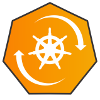- Published on
Stakater Reloader
- Authors
- Name
- Alexander Arana Escobedo

To obtain the latest Secret as an environment variable in your pod, you need to restart it
The Secrets Store CSI Driver docs recommend using the Reloader tool by Stakater.
Reloader also monitors changes in ConfigMaps and automatically performs rolling upgrades on the relevant DeploymentConfig, Deployment, Daemonset, Statefulset and Rollout.
To see an example of how this works, check the code block below.
Script.ps1
<#
.DESCRIPTION
Use this script to add the Reloader tool to an existing cluster.
This scenario is possible provided that you have a Key Vault and a cluster setup that can access your Azure Key Vault using workload identity.
If you don't have the setup, you can check the following resources:
https://github.com/aranaescobedo/workload-id-csi-aks
.NOTES
AUTHOR: Alexander Arana E
LASTEDIT: Dec 05, 2023
#>
$helmName = "<ADD_HELM_NAME>"
$idClientId = "<ADD_CLIENT_ID_FROM_USER_ASSIGNED_IDENTITY>"
$kvName = "<ADD_KEY_VAULT_NAME>"
$secretName = "<ADD_SECRET_NAME>"
$serviceAccountName = "<SERVICE_ACCOUNT_NAME>"
$namespaceName = "demo"
$nodePoolName = "<ADD_POOL_NAME>"
$tenantId = "<ADD_TENANT_ID>"
#Install Reloader with HELM.
helm repo add stakater https://stakater.github.io/stakater-charts
helm repo update
helm install $helmName stakater/reloader `
--namespace kube-system `
--set reloader.watchGlobally=true `
--set reloader.namespaceSelector="reloader=true" `
--set reloader.deployment.nodeSelector.agentpool=$nodePoolName
#If you need to delete the HELM chart.
#helm uninstall $helmName --namespace kube-system
#Create namespace.
kubectl create namespace $namespaceName
#Add label to namecespace.
kubectl label namespaces $namespaceName reloader=true
#Apply the Reloader label into the pod resource
echo @"
apiVersion: apps/v1
kind: Deployment
metadata:
name: reloader-deploy
annotations:
reloader.stakater.com/auto: "true"
namespace: $namespaceName
labels:
app: reloader-app
spec:
replicas: 1
selector:
matchLabels:
name: reloader-deploy
strategy:
type: RollingUpdate
rollingUpdate:
maxSurge: 1
maxUnavailable: 0
template:
metadata:
labels:
name: reloader-deploy
app: reloader-app
azure.workload.identity/use: "true"
spec:
serviceAccountName: $serviceAccountName
nodeSelector:
agentpool: $nodePoolName
securityContext:
runAsUser: 999
runAsGroup: 999
runAsNonRoot: true
containers:
- name: reloader-container
image: docker.io/aranaescobedo/workload-id-app-aks:1.0
imagePullPolicy: IfNotPresent
envFrom:
- secretRef:
name: secret-creds
volumeMounts:
- name: secrets-store-inline
mountPath: "/mnt/secrets-store"
readOnly: true
volumes:
- name: secrets-store-inline
csi:
driver: secrets-store.csi.k8s.io
readOnly: true
volumeAttributes:
secretProviderClass: secret-spc
---
apiVersion: secrets-store.csi.x-k8s.io/v1
kind: SecretProviderClass
metadata:
name: secret-spc
namespace: $namespaceName
spec:
provider: azure
secretObjects:
- secretName: secret-creds
data:
- key: SECRET_NAME
objectName: $secretName
type: Opaque
parameters:
usePodIdentity: "false"
useVMManagedIdentity: "false"
clientID: $idClientId
keyvaultName: $kvName
cloudName: ""
objects: |
array:
- |
objectName: $secretName
objectType: secret
objectVersion: ""
tenantId: $tenantId
"@ > deploy.yaml | kubectl apply -f deploy.yaml
💡 Tip!
If it’s time to update the Stakater Helm chart, you can fetch the available versions as follows:
# Add the Stakater Helm repository (if you haven’t already):
helm repo add stakater https://stakater.github.io/stakater-charts
helm repo update
# Search for available chart versions:
helm search repo stakater/reloader --versions
I hope this guide helps you out! If you have any questions, don’t hesitate to reach out.
Alexander Arana.E